Eye Strain Prevention: Essential Strategies for Protecting Your Eyes
Updated On: October 24, 2025 by Aaron Connolly
Understanding Eye Strain
Eye strain creeps in when we push our eyes too hard for too long. It’s a daily reality for millions, especially if you’re glued to a computer or gaming for hours on end.
What Is Eye Strain?
We use the term eye strain to describe that tired, uncomfortable feeling our eyes get after focusing too hard. It’s not an official diagnosis, but most of us know exactly what it feels like.
When you stare at screens, books, or tiny details for too long, your eye muscles work overtime. That’s when your eyes start to feel sore or just plain worn out.
Eye fatigue and eyestrain? Pretty much the same thing. Both mean your eyes are overworked and unhappy.
Good news: it’s temporary and won’t wreck your vision permanently. Still, it can make everyday stuff feel way harder than it should.
A lot of folks deal with eye strain without even realizing what’s going on. If you know the basics, it’s easier to tell when your eyes need a break.
Common Causes of Eye Strain
Digital devices top the list these days. Computers, phones, tablets, and gaming screens make our eyes work nonstop.
We naturally blink about 15-20 times a minute, but that drops to 5-7 when we’re glued to a screen. Wild, right?
Close-up work like reading tiny print or doing crafts also makes our focusing muscles ache. Our eyes don’t get to relax if we stay locked in on near stuff.
Lighting matters too. Dim lights make you squint, while glare from windows or lamps can be just as bad. If your work area is lit differently than the rest of the room, your eyes have to keep adjusting.
Environmental factors don’t help:
- Air conditioners blowing in your face
- Dry air from heaters
- Dust or fingerprints on your glasses or screen
If you have uncorrected vision problems, your eyes work even harder. The wrong prescription makes everything worse.
Symptoms and Warning Signs
Irritated eyes usually show up first. You might notice dryness, watering, or a gritty feeling that just won’t quit.
Physical symptoms can include:
- Burning or itching
- Trouble keeping your eyes open
- Eye twitches or spasms
- Sensitivity to light
You might also get:
- Blurry vision when you look up from your screen
- Double vision that comes and goes
- Difficulty switching focus from near to far
Headaches are common. The ache often starts behind your eyes and can creep across your forehead.
Sometimes, you’ll get neck or shoulder pain from hunching over. Blurry vision can lead to reading mistakes or just make it tough to concentrate.
Usually, taking a break helps these symptoms fade. But if you rest and still feel lousy, it’s time to check in with an eye care pro.
Importance of Eye Care
Regular eye exams catch eye issues early and help stop strain from getting out of control. Talking with an eye care pro makes sure you get the right fix for your eyes.
Role of Routine Eye Exams
Don’t wait for problems to show up—get your eyes checked routinely. These exams can spot health problems you wouldn’t expect, not just vision stuff.
Your optometrist might catch signs of diabetes or high blood pressure before you notice anything else is wrong. It’s kind of surprising how much your eyes can reveal.
How often should you go?
- Under 40: Every 2-3 years
- Ages 40-65: Every 1-2 years
- Over 65: Every year
Your doctor will check if your prescription needs updating. Wearing old glasses or contacts makes your eyes work too hard, which leads to headaches and tiredness.
They’ll also look for dry eye issues. Sometimes, artificial drops won’t cut it if you have a deeper tear film problem.
When to Consult an Optometrist
Book an appointment if your eye strain doesn’t let up, even after trying basic fixes. Some symptoms really need professional attention.
Call your optometrist if you notice:
- Blurry vision that sticks around after breaks
- Headaches behind your eyes that won’t quit
- Double vision or halos
- Pain when looking at bright lights
- Symptoms that keep getting worse
If you stare at screens all day, you might need computer glasses. These focus at the right distance for screens, so your eyes don’t have to work as hard.
Anti-reflective coatings can cut down glare from screens and overhead lights. They’re more effective than blue light filters, which honestly don’t have much research backing them up.
If you find yourself squinting or holding stuff far away to read, your prescription might need an update.
Screen Time Management
Keeping tabs on your screen time can make a big difference. Setting limits and actually checking how long you’re on devices will help your eyes in the long run.
Limiting Screen Time
Set a cap on your daily screen time if you want to keep eye strain at bay. The 20-20-20 rule is a classic: every 20 minutes, look at something 20 feet away for 20 seconds.
It sounds simple, but it really does let your eyes reset.
Here are some screen time limits to aim for:
- Adults: 8-10 hours max
- Teens: 6-8 hours
- Kids: 2-4 hours
Try to cut off non-essential screen time one or two hours before sleep. You’ll sleep better and your eyes will thank you.
Make screen-free zones in bedrooms or at the dinner table. Leave devices in another room during meals or when hanging out with family.
Swap some digital time for offline stuff like reading paper books or heading outside.
Tracking Digital Device Use
Use your phone’s built-in tools to see how much time you’re actually spending on screens. Most of us underestimate it, honestly.
Some handy tracking tools:
- iPhone: Screen Time
- Android: Digital Wellbeing
- Windows: Microsoft Family Safety
- Mac: Screen Time
Set app limits for games, social media, and streaming. Don’t try to cut everything at once—start by trimming 15-20% off your current use.
Check your weekly reports, maybe every Sunday. Notice which apps eat up your time and when you’re most likely to overdo it.
A lot of people find they’re on devices 2-3 hours more than they thought. Use that info to decide what to cut back on first.
Optimal Screen Setup
How you set up your screen really matters. Distance, brightness, and even your font choices all play a part in keeping your eyes happy.
Proper Screen Positioning
Put your monitor about 20 to 26 inches away—think arm’s length. That’s usually the sweet spot.
Keep the centre of your screen 4 to 5 inches below your eyes. Looking down just a little helps your neck and eyes relax.
Make sure your monitor sits right in front of you. If you angle it to the side, your eyes and head work harder, and you might get headaches.
For different monitor sizes, here’s a quick chart:
| Monitor Size | Resolution | Ideal Distance |
|---|---|---|
| 24 inch | 1080p | 3.2 ft |
| 24 inch | 1440p | 2.3-3.2 ft |
| 27 inch | 1080p | 3.4-3.6 ft |
| 27 inch | 1440p | 2.6-3.6 ft |
| 32 inch | 1440p | 3.2-4.3 ft |
If your monitor is too low, stack a few books or use a monitor arm to raise it.
Adjusting Display Brightness
Match your screen brightness to your room’s lighting. If your screen’s way brighter or dimmer than your room, your eyes have to keep adjusting.
In a dark room, keep brightness low—0-20% is usually enough. Adding a bit of LED backlight behind your monitor can help too.
If your room is bright or you’re near a window, crank brightness up to 100-150 cd/m² so you don’t have to squint.
Set contrast to about 50-70%. Too much contrast makes your eyes work overtime, especially with lots of dark and light spots.
A super-bright screen in a dark room is a fast track to eye strain. I’ve learned that the hard way.
Check your refresh rate, too. Go for 75Hz or higher if you can—lower rates can cause flicker, even if you don’t notice it right away.
Font Size and Colour Adjustments
Tiny text is a pain. Set your font size to at least 12 points so you’re not squinting or leaning in.
Arial is a solid choice—easy to read, no fuss. Skip the fancy fonts with thin lines or weird shapes.
Dial down the blue light, especially at night. Lower your monitor’s blue light setting until the screen looks a little yellowish.
Set your colour temperature to 6500K or less. That’ll take the harsh edge off blue light.
For RGB, leave red and green alone but nudge blue down until things look comfortably warm.
Dark mode is your friend, especially in dim rooms. White backgrounds are just rough on tired eyes.
Reducing Glare and Reflection
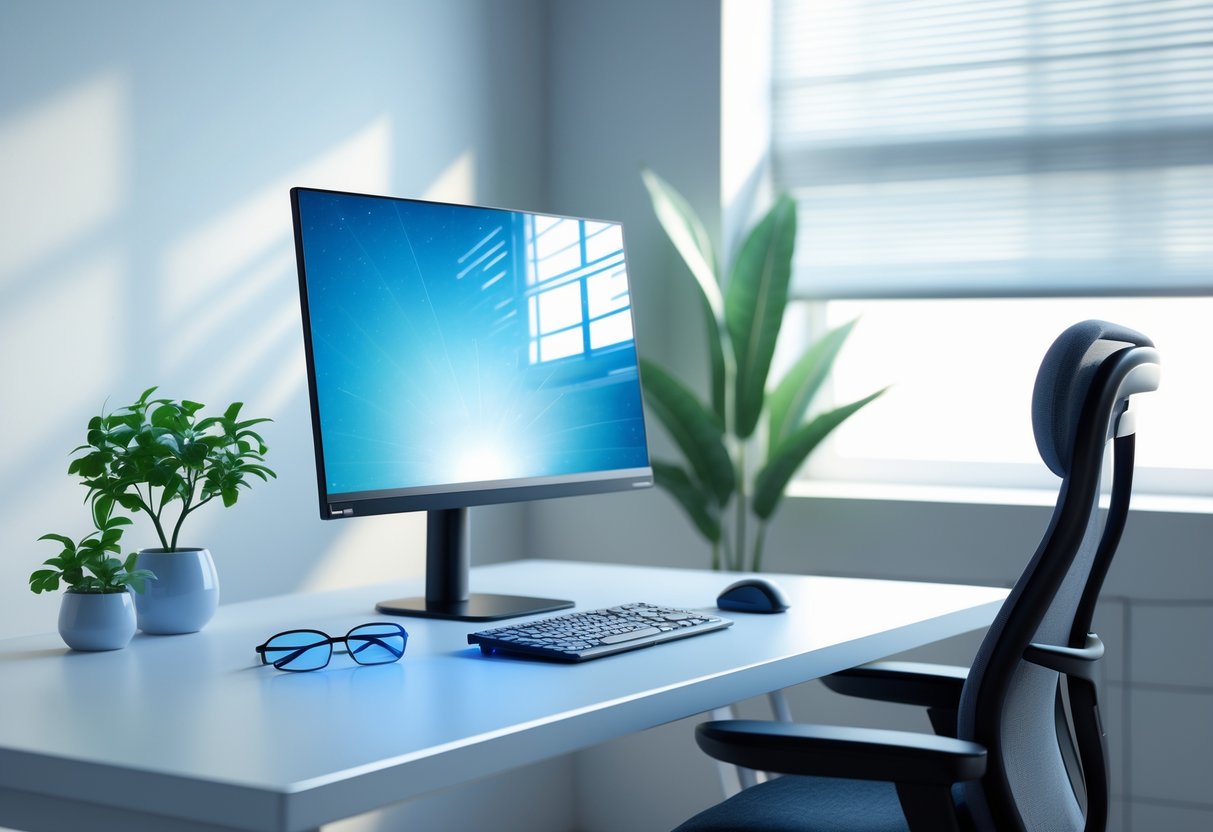
Glare from screens and lights can make your eyes ache and mess with your focus. You can fight back with a few lighting tweaks and the right lens coatings.
Minimising Ambient Glare
Move your screen so it’s not facing direct light. Windows behind or in front of your monitor are the worst for glare. Try putting your screen at a right angle to windows instead.
Adjust your room lighting. Overhead fluorescents can bounce off your screen and strain your eyes. Use fewer bulbs or switch to a softer desk lamp beside your monitor.
Control sunlight with curtains or blinds. During the brightest part of the day, close them partway to cut harsh contrasts.
Think about your setup. Keep your screen 20 to 26 inches away, with the centre just below eye level. That angle helps cut glare from ceiling lights.
If you still get reflections, try a screen filter. Anti-glare protectors can help, though they might make your screen a bit dimmer.
Importance of Anti-Reflective Coating
Anti-reflective coating cuts glare by up to 99%. You’ll find this thin layer on your glasses; it stops light from bouncing off the lens and shining back into your eyes.
The coating covers both sides of the lens. It blocks glare from things like screens and overhead lights, and also stops reflections from light hitting the back of your glasses.
You can combine anti-reflective coating with other lens treatments. Amber tints filter blue light, while UV coatings protect you from harsh rays—especially if you’re gaming during daylight hours.
Gaming expert James Connolly once said, “Anti-reflective coatings made the biggest difference to my eye comfort during tournament prep. The constant screen glare was giving me headaches after just two hours.”
Plan to spend £20-50 extra for a good anti-reflective coating. Cheaper options might wear off fast or leave a weird purple tint. I’d go with a reputable optical provider if you want the coating to last.
Lighting and Ergonomics
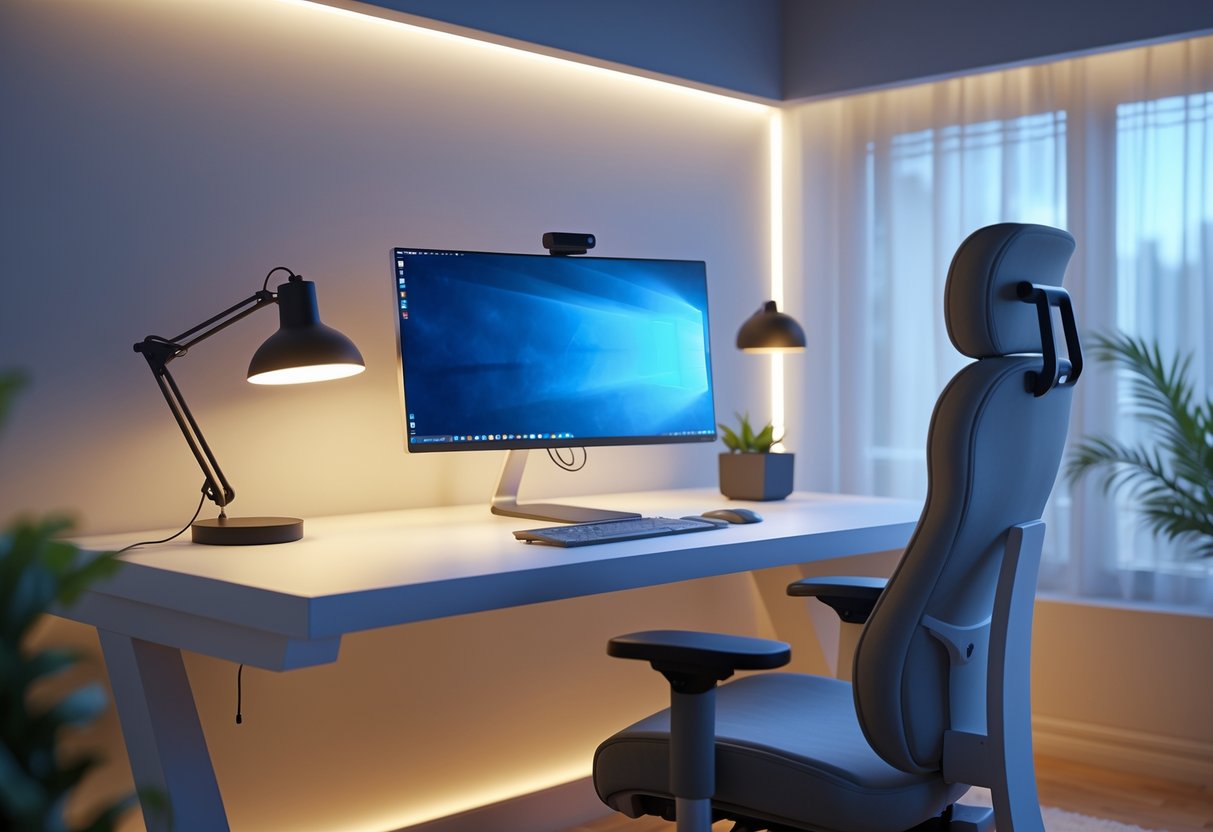
Poor lighting and bad posture force your eyes to work harder than they should. The right lighting setup and proper workstation positioning can make a huge difference during marathon gaming sessions.
Choosing the Right Lighting
Natural light is best, but you need to control it. Put your monitor perpendicular to windows—not right in front or behind them. That way, you avoid harsh glare but still get the benefits of daylight.
Overhead fluorescent lights can be a real pain. They create patchy lighting that makes your eyes keep adjusting between your bright screen and the darker room.
LED desk lamps give you the most control. Look for ones with adjustable brightness and color temperature. Warmer light (around 3000K) is easier on your eyes at night, while cooler light (about 5000K) helps you stay alert during the day.
Monitors with anti-reflective coatings help a lot. These coatings cut down glare from overhead lights and windows. Lots of gaming monitors now include this as a standard feature.
Ambient lighting behind your monitor eases contrast stress. Stick a simple LED strip behind your screen to create a bit of background light. It stops your eyes from straining to adjust between your bright screen and a dark room.
Workstation Ergonomics
Keep your monitor 50-70cm from your eyes. This distance lets your eyes relax and keeps text crisp.
Screen height is a bigger deal than most gamers realize. Set the top of your monitor level with your eyes or just below. This keeps your neck neutral and cuts down on tension that can add to eye strain.
Tilt your screen back 10-20 degrees. That matches your natural gaze and helps with reflections from overhead lights.
Don’t forget to take regular breaks using the 20-20-20 rule. Every 20 minutes, look at something 20 feet away for 20 seconds. It gives your eye muscles a quick reset.
Adjust your chair so your feet are flat on the floor. Bad posture tenses your neck and shoulders, which only makes eye strain worse during long sessions.
Blinking and Lubrication
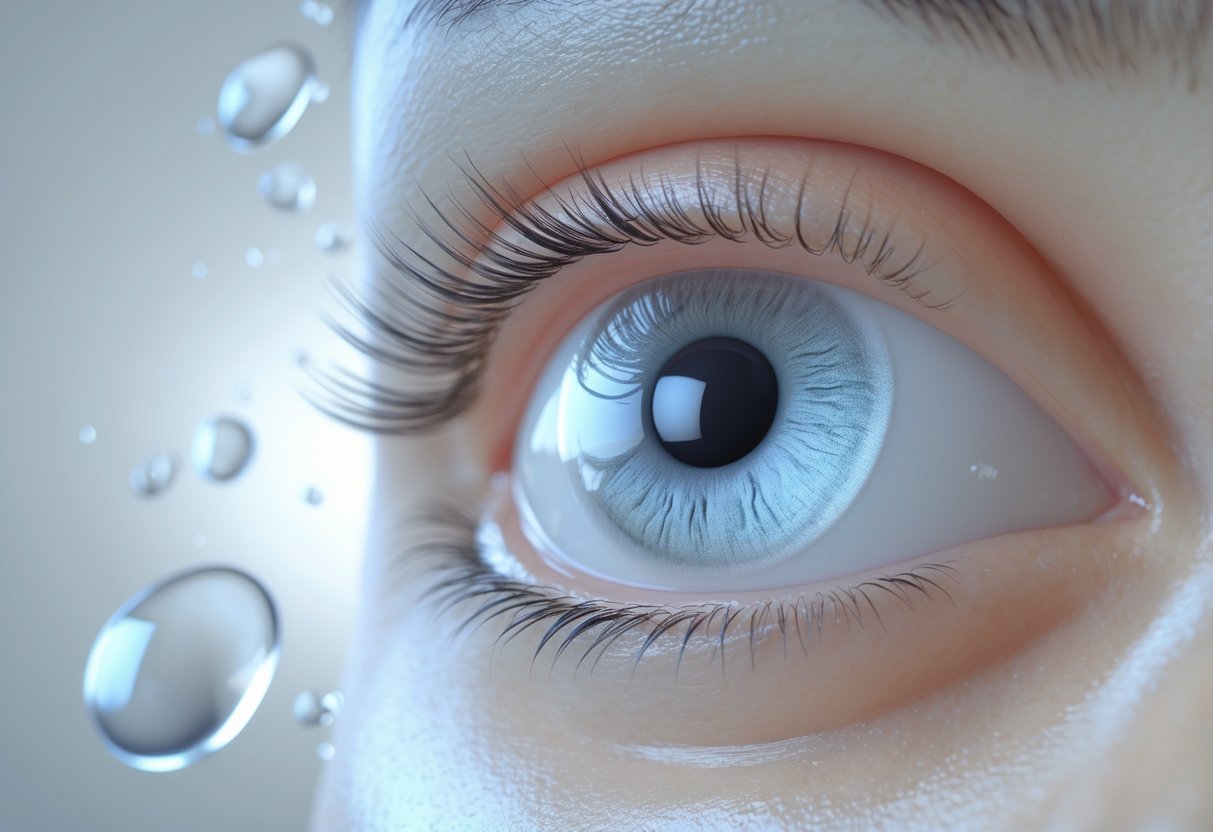
Blinking properly keeps your eyes moist and comfortable during screen time. If you don’t blink enough, your eyes dry out and get irritated, making eye strain way worse.
Why Blinking Matters
We honestly forget how important blinking is. Every blink spreads a thin layer of tears across your eyes, keeping them moist and clean.
When you stare at screens, you blink way less often. Normally, you blink 15-20 times a minute, but with screens, it drops to just 5-7.
Problems creep in quickly. Your tears dry up. The surface of your eyes gets rough, not smooth. Light scatters, and your vision blurs.
Try quick blinking exercises to help. Blink rapidly for 20 seconds every hour. Close your eyes gently, pause for two seconds, then open them slowly. That helps restore the tear film.
Heads up: Incomplete blinking doesn’t cut it. Make sure you close your eyes all the way each time.
Using Artificial Tears
Artificial tears add extra moisture when blinking isn’t enough. They work best if you keep up good blinking habits too.
Go for preservative-free drops if you use them more than four times a day. Preservatives can irritate your eyes if you rely on them too much.
Use artificial tears before your eyes get dry. Once dryness sets in, it’s harder to fix. Put one drop in each eye, blink gently, and wait a minute before going back to your screen.
Quick tip: Keep artificial tears at your desk so you don’t forget.
Some folks need artificial tears more often. If you wear contacts or work in air-conditioned spaces, you might need them a few times a day.
Maintaining Healthy Humidity and Air Quality
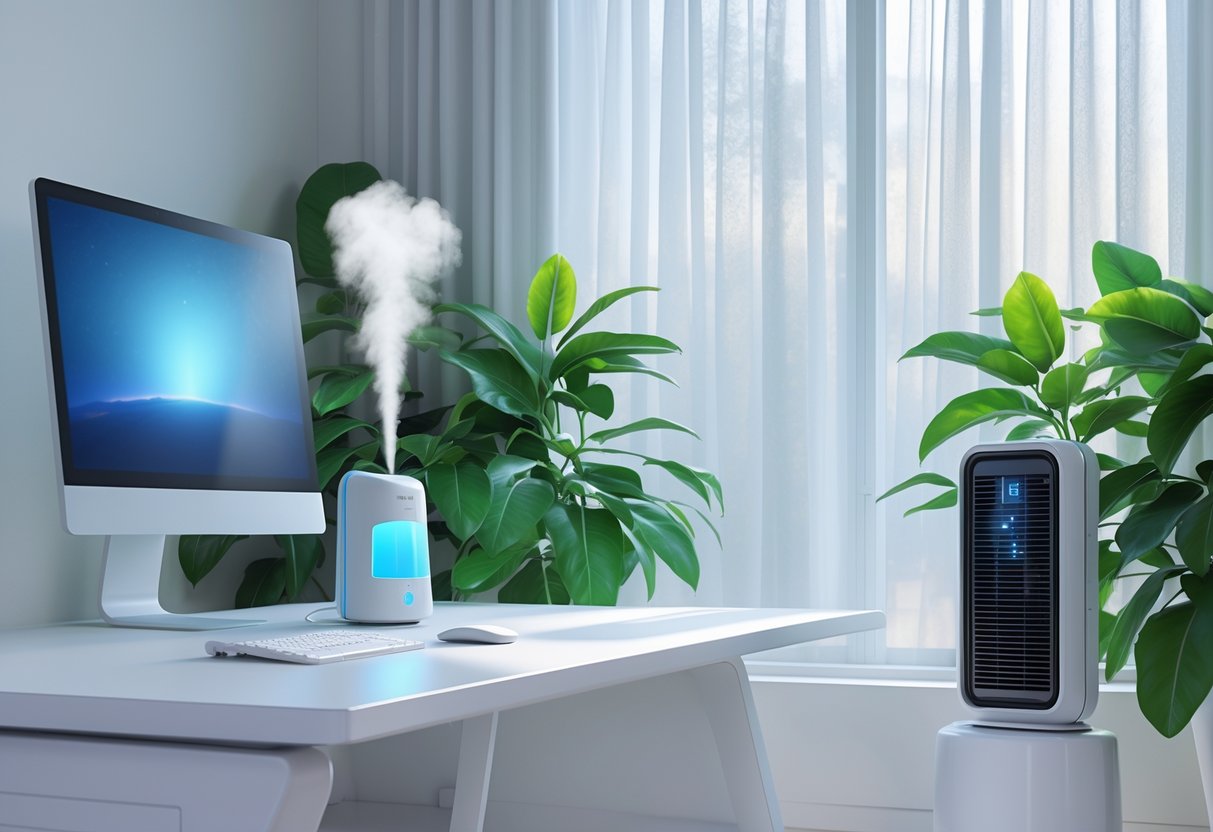
The air around you has a big impact on eye comfort and avoiding strain. Dry air and lousy air quality make your eyes work overtime and can leave them irritated and tired.
Impact of Dry Environments
Dry air is brutal for comfortable eyes. If humidity drops below 30%, your tears evaporate way faster than normal.
Your eyes try to make more tears to keep up, but the dry air just steals that moisture again.
Air conditioning and heating systems make things worse. They suck moisture out of the air and move it around your room.
Fans or AC units blowing directly on you are even harsher. The constant air movement means your tears dry up even faster.
You’ll really notice this in winter. Heating systems can drop indoor humidity to just 10-20%. That’s drier than a lot of deserts.
Bad air quality adds even more problems. Dust, allergens, and pollutants irritate your eyes directly. They make dry eyes feel even worse.
Benefits of Humidity for Eye Comfort
Keeping humidity between 30% and 50% creates a good environment for your eyes. This helps your natural tear film last longer.
A basic humidifier can totally change your workspace. Put it near your desk, but not so close that it fogs up your screen.
Watch where you put air vents. Make sure fans, heaters, or ACs aren’t blasting air at your face or workspace.
Check your humidity with a cheap hygrometer. Most cost less than £15 and let you keep tabs on things throughout the day.
Use an air purifier if you live somewhere polluted. Clean air means less irritation and helps prevent that burning feeling from bad air.
Even small plants help. They naturally add some moisture and filter a few pollutants out of the air.
Practising the 20-20-20 Rule
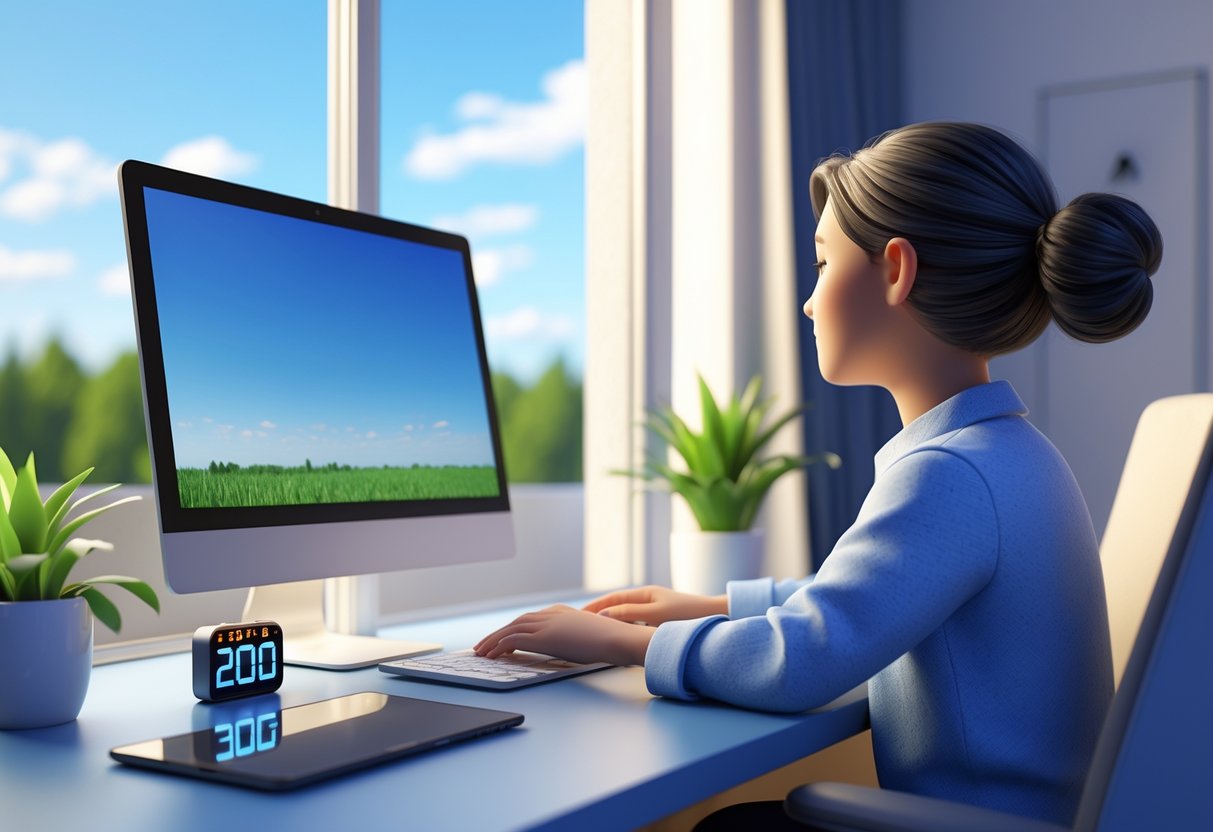
The 20-20-20 rule is a simple trick to cut eye strain: look at something 20 feet away for 20 seconds every 20 minutes. To make it work, you’ll want to know why it helps and how to build it into your daily habits.
How the 20-20-20 Rule Works
Your eyes work hardest when focusing on close stuff like screens. The muscles inside your eyes contract to keep things sharp. After 20 minutes, those muscles get tired.
Looking at something far away relaxes those muscles. When you shift your gaze to something 20 feet away, your eyes can rest and reset. That distance makes your eyes switch from near vision to far vision.
The 20-second break is key. Research shows your eye muscles need at least 15-20 seconds to really relax. This short pause helps stop the eye fatigue that leads to headaches and blurry vision.
Kids often don’t notice eye strain as quickly as adults. We need to keep an eye on their screen time and remind them to take breaks.
The rule works even better with proper blinking. We blink less at screens, which dries out our eyes. During each 20-second break, make sure to blink consciously to restore moisture.
Incorporating Breaks Into Our Routine
Reminders help us stick to the 20-20-20 rule. Use phone timers, computer notifications, or apps that nudge you every 20 minutes.
Some reminder ideas:
- Computer break software
- Smartphone apps with custom alerts
- A simple kitchen timer on your desk
- Calendar notifications every 20 minutes
Where you look during breaks matters. Pick something genuinely 20 feet away—across the room, out a window, or down a hallway. A wall five feet away just won’t cut it.
Make breaks count by standing up now and then. Every hour or two, step away from the screen for a few minutes. That gives your eyes a real rest and helps your neck and shoulders too.
Heads up: Just glancing at something nearby doesn’t really relax your eyes. You need that full 20-foot distance for the muscles to unwind.
Track how your eyes feel throughout the day. Most people notice less fatigue and fewer headaches after a week of sticking to the rule.
Lifestyle Adjustments for Eye Health
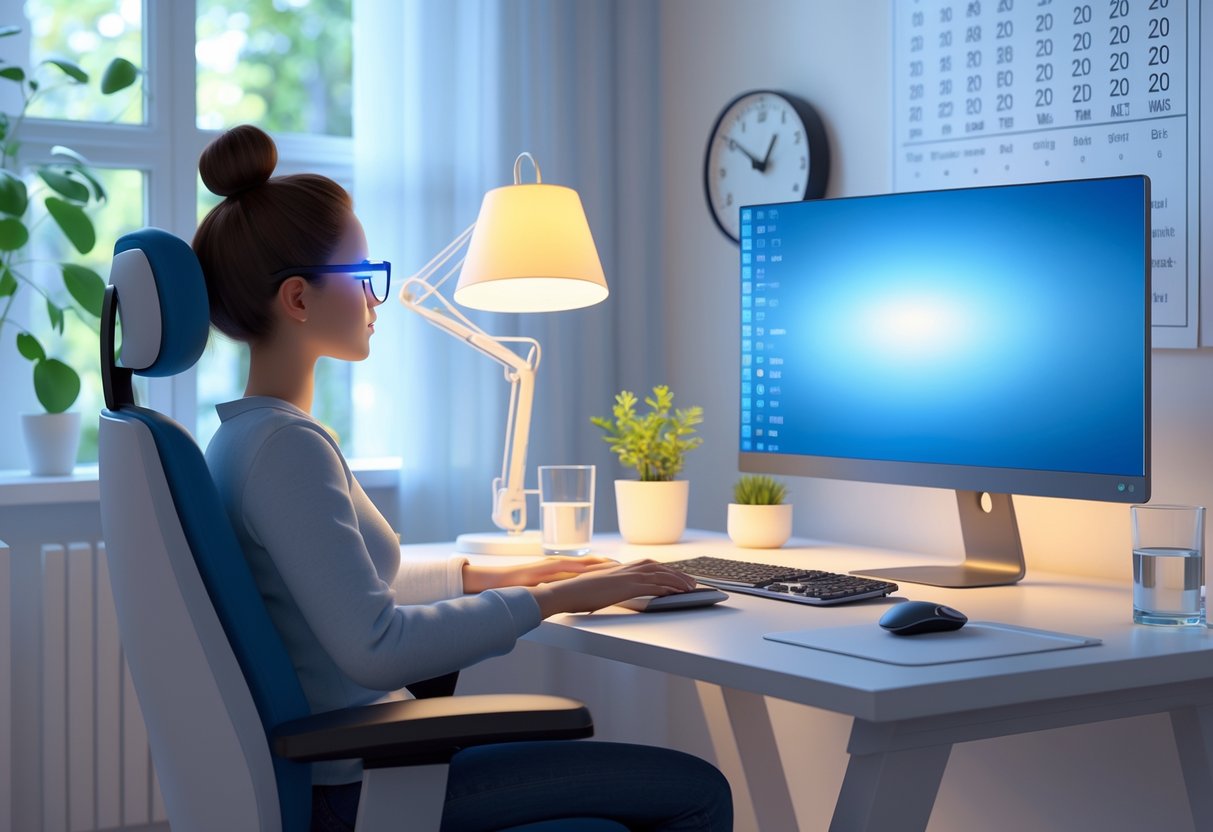
Simple daily habits outside of screen time can make a huge difference for your eyes. Good nutrition and steady routines work together to cut strain and keep your eyes healthy long-term.
Healthy Routines Beyond Screens
Regular sleep is the base of good eye care. If you don’t sleep enough, your eyes dry out and get irritated more easily.
Shoot for 7-9 hours of solid sleep each night. This gives your eyes time to recover. Bad sleep also messes with your focus the next day.
Stay hydrated by drinking enough water. Dehydration messes with tear production and can leave your eyes feeling gritty.
Take breaks from all close-up work, not just screens. Reading, crafts, or anything detailed counts too.
Exercise boosts blood flow to your eyes. Even a short walk helps bring nutrients in and clear out waste.
Try a humidifier if your environment is dry. AC and heating systems dry out the air, especially in winter.
Eye-Friendly Nutrition
Certain nutrients really protect your eyes from strain and damage. A balanced diet works better than supplements alone.
Add these nutrients to your meals:
- Omega-3s from fish, walnuts, or flax seeds help prevent dry eyes
- Vitamin A from carrots, sweet potatoes, and spinach supports night vision
- Vitamin C from citrus and berries helps protect against damage
- Vitamin E from nuts and seeds acts as an antioxidant
Dark leafy greens are a must. Spinach, kale, and Swiss chard have lutein and zeaxanthin, which naturally filter out some blue light.
Cut back on processed foods and too much sugar. They can cause inflammation, including in your eyes.
Eat on a regular schedule. Skipping meals can mess with blood sugar, which affects your ability to focus.
Vision Correction and Eyewear Choices
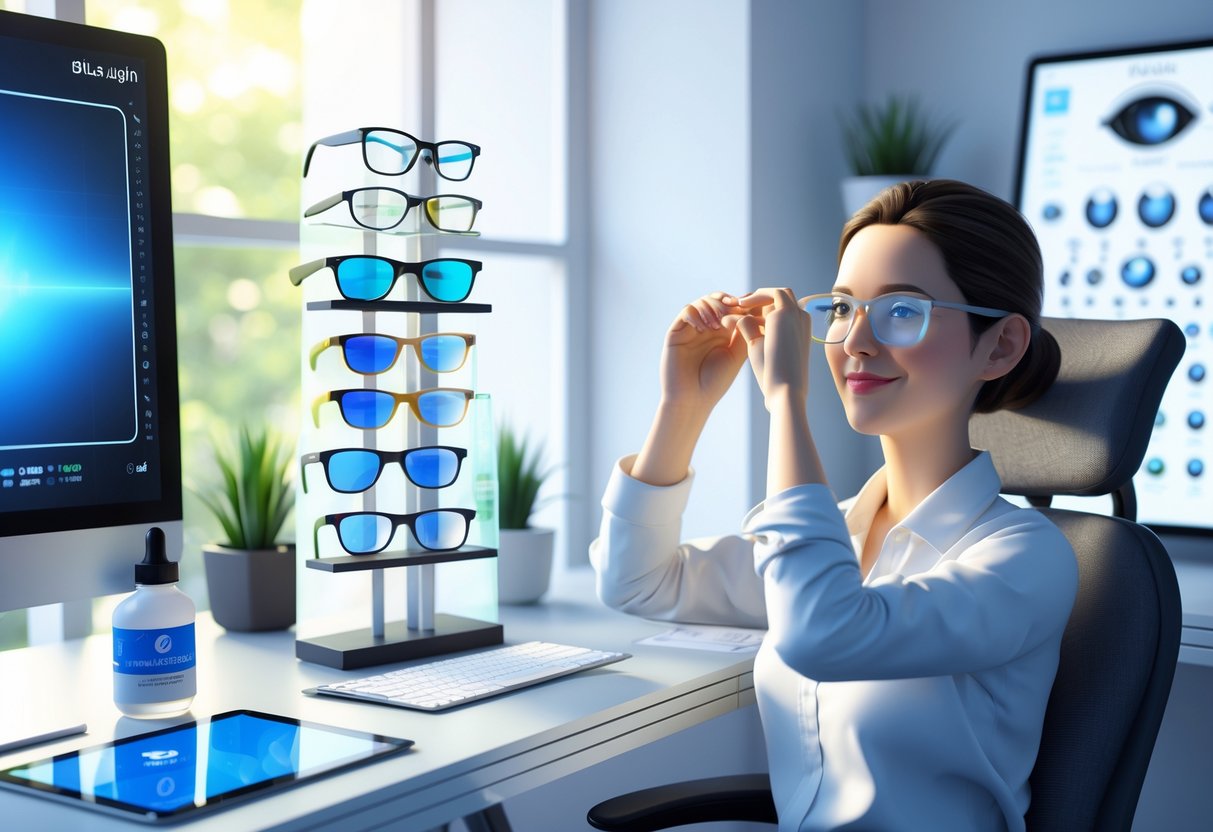
The right glasses or contacts can stop eye strain before it starts. Blue light filtering tech adds a bit of extra protection if you spend hours gaming or watching streams.
Choosing Glasses or Contact Lenses
Glasses give you the most flexible protection against eye strain. They put a barrier between your eyes and screens, and you can add helpful coatings.
Anti-reflective coating cuts glare from monitors and overhead lights. It lets more light through your lenses and helps reduce visual distractions.
Computer glasses really shine during long gaming sessions. Their lenses fit the 20-26 inch distance from your eyes to your monitor. They help you avoid squinting and leaning forward, which leads to neck pain.
Gamers over 40 often pick progressive lenses. These lenses have zones for different distances, so switching between your screen and phone feels easier.
Contact lenses give you a wider field of vision since there are no frames blocking your sides. Still, they might make dry eye symptoms worse if you game for hours.
A lot of people who wear contacts keep backup glasses with anti-reflective coating. This way, you have options when your eyes get tired.
Role of Blue Light Filtering Options
Blue light filtering lenses help cut down on exposure to high-energy light from screens. Digital displays send out a lot of blue light that can cause headaches and mess with your sleep.
If you game for more than two hours a day, these lenses can really help. They ease dry eyes and trouble focusing.
The filtering barely changes your screen colours. Most blue light lenses just have a slight yellow tint that’s hard to notice.
You can get blue light filtering and anti-reflective coating on the same pair. This combo fights both glare and blue light.
Photochromic lenses add extra protection if you move between different lighting. They adjust to brightness and still keep blue light filtering indoors.
When Eye Strain Indicates a Bigger Problem
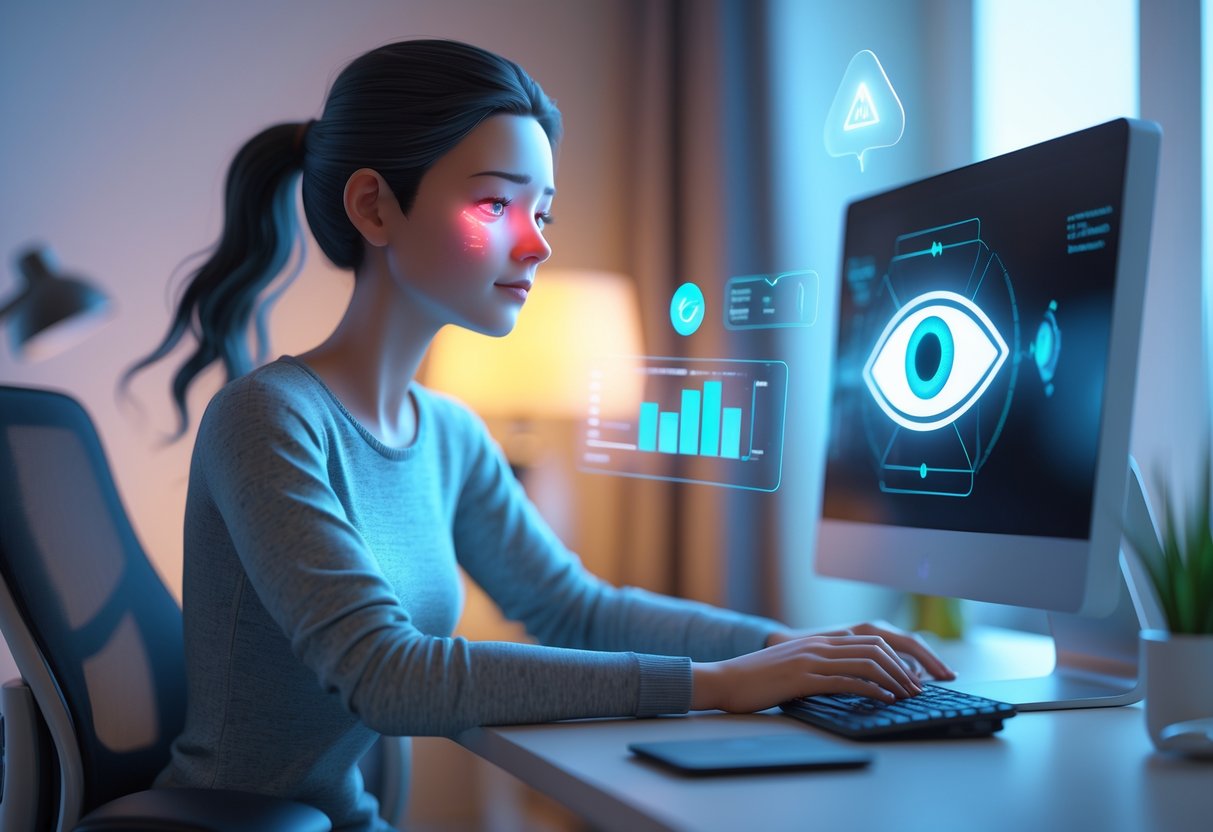
Most eye strain fades with rest. But if symptoms stick around or mess with your daily life, they might signal vision problems that need a professional look.
Some warning signs mean you should get an eye exam to rule out anything serious.
Persistent Symptoms to Watch For
Eye strain that hangs on for days or weeks after you rest your eyes isn’t normal. If your vision stays blurry, you get severe headaches with screen use, or your eyes burn even when you aren’t near devices, something else could be going on.
Physical symptoms matter too. If neck and shoulder pain keeps showing up because you adjust your posture to see, you might need corrective lenses.
Look out for these red flags:
- Headaches every day or that get worse as the day goes on
- Double vision or halos around lights
- Trouble reading text at normal distances
- Eye pain that’s sharp or stabbing
- Sudden changes in how clearly you see
Dry eye syndrome can fool you into thinking it’s just eye strain. If artificial tears don’t help or your eyes feel gritty even after sleep, you might need a prescription.
Getting Professional Help
An optometrist can check out eye strain that doesn’t improve with basic prevention. They spot vision problems like astigmatism, presbyopia, or issues with eye muscles that make close work tough.
Book an eye exam if eye strain gets in the way of work, reading, or daily stuff for more than two weeks. Lots of people need computer glasses or an updated prescription and don’t even realize it.
Annual eye exams are a must if you spend over six hours a day on screens. Your optometrist will:
- Look for hidden vision problems
- Prescribe computer glasses with anti-glare coating
- Catch early signs of glaucoma
- Suggest treatments for dry eyes
If you get eye strain with severe headaches, don’t ignore it. This combo could mean eye muscle issues or high eye pressure that needs quick attention.
Frequently Asked Questions

Millions of people deal with eye strain every day. It can be uncomfortable and really drag down your productivity.
Here are some straightforward answers to common questions about managing and preventing eye strain.
What are the best ways to quickly relieve eye strain?
The 20-20-20 rule is simple and works fast. Every 20 minutes, look at something 20 feet away for 20 seconds.
Artificial tears can soothe dry, irritated eyes. Use them when your eyes feel scratchy or tired.
Try to blink more often. We often forget to blink enough when staring at screens.
Taking a longer break away from visual work gives your eyes real rest. Step outside during lunch if you’ve been at the computer all morning.
Can you describe the symptoms of eye strain?
Tired or irritated eyes are the most common signs. Your eyes might feel heavy after focusing for a while.
Dryness and redness pop up when we don’t blink enough at screens. Eyes start to feel scratchy or gritty.
You might notice blurry vision after long visual tasks. Things can look fuzzy or out of focus.
Eye twitching and muscle fatigue around your eyes mean your eye muscles are working too hard. Headaches often show up with these symptoms.
How can one alleviate headaches caused by eye strain?
Good lighting makes a big difference. Try to have light coming from behind you when reading.
Set your screen at eye level or a bit below. Screens that are too high or low make your neck hurt and bring on headaches.
Cut glare with window shades or screen filters. Bright reflections force your eyes to work overtime.
Take regular breaks from tough visual work. Mix in activities that use your eyes differently.
What home remedies are effective for eye strain treatment?
Cool compresses can shrink puffiness and help tired eyes. Try one for 10-15 minutes when you feel symptoms.
Add humidity if your air is dry with a humidifier. Dry air can make eye irritation worse.
Move heating or cooling vents so air doesn’t hit your face. Blowing air dries out your eyes fast.
Make text bigger on your devices so you don’t have to squint. Most devices let you change text size in settings.
What methods are recommended to prevent eye strain whilst using computers?
Keep your screen at arm’s length, about 50-70 centimetres away. The top of the screen should be at or just below eye level.
A document stand between your keyboard and monitor helps keep reference materials in view. This saves you from constant head turning.
Match your screen brightness to your room. The screen shouldn’t be the brightest or darkest thing you see.
Take lots of breaks—even more than the 20-20-20 rule. Stand up, stretch, and do something that doesn’t involve staring at a screen.
How long is eye strain likely to persist?
If you’ve got mild eye strain, it usually fades within a few hours after you stop the activity that triggered it. Just getting some rest tends to help, and by the next day, your eyes might feel back to normal.
But if you’re staring at a computer every day, things get trickier. Eye strain can stick around until you actually change something in your environment.
Sometimes, symptoms drag on for days or even weeks if you don’t take action. That’s when it starts to feel frustrating.
If your eye strain feels severe or just won’t quit after a few days, you should really talk to a doctor. It might be a sign of something more serious, like a vision issue or another health problem.
When people start using good eye care habits, most notice things get better in a day or two. Sticking with those habits works best for keeping your eyes comfortable in the long run.

